 Love him or hate him, Sonic the Hedgehog is synonymous with SEGA. Sonic was a force to be reckoned with during the 16-bit days, delighting players everywhere and striking fear into the hearts of SEGA’s competition. Sonic was where it was at. Sonic was cool, and Sonic was only on SEGA.
Love him or hate him, Sonic the Hedgehog is synonymous with SEGA. Sonic was a force to be reckoned with during the 16-bit days, delighting players everywhere and striking fear into the hearts of SEGA’s competition. Sonic was where it was at. Sonic was cool, and Sonic was only on SEGA.
When the Saturn ‘exploded’ onto the western gaming scene at E3 1995 (cough, cough), many thought it was a foregone conclusion that the Blue Blur would headline the 32-bit generation… and yet, he was nowhere to be found. Aside from a brief cameo in Bug!, Sonic was absent from the Saturn launch lineup. Nintendo launched their new machine with a Mario game. Sony was desperate for a mascot before settling on Crash and giving him a huge push… but Sonic? He was still hanging out in 16-bit land, and his absence did not go unnoticed.
In the fullness of time, the Saturn would play host to a trilogy of Sonic games, yet they were curious choices for bringing SEGA’s megastar over to everyone’s favorite system. Despite their considerable bells and whistles, both 1996’s Sonic 3D Blast and 1997’s Sonic Jam were games that had their roots in SEGA Genesis development. It wasn’t until Sonic’s final Saturn outing, 1997’s Sonic R, that gamers would see a Sonic title that was built for the Saturn from the ground up. And? Well, we ended up with Sonic R.
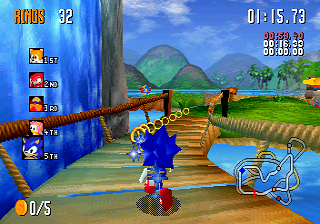
Resort Island: the obligatory Sonic-esque first level
Now, I’ve just painted that in a negative light, and perhaps that is not fair. Still, as the gaming world saw the Mario platforming experience evolve from 2D brilliance to 3D excellence, and Sony successfully push a 3D mascot of their own, legions of Sonic fans wanted to see their favorite hedgehog in a fully 3D adventure. When Sonic X-Treme died, for many of us a little bit of hope died along with it. As great as it was to receive a fully 3D Sonic game on the Saturn, it wasn’t the platformer that everyone wanted.
There. With that out of the way, let’s have a proper look at Sonic R, for what it is… and, just what is it, exactly?
Sonic R is a kart racing game without the karts, for the most part. As expected, Dr. Robotnik pilots his customary hovercraft and for some reason Amy Rose drives in a buggy, but everyone else is on foot. The player selects a character from the Sonic Universe – Sonic, Tails, Knuckles, Amy Rose, or eventually, Dr. Robotnik himself. There are 4 other mechanical characters to unlock, but for those that haven’t played the game, let’s not spoil the character surprise. Suffice to say there are 9+1 characters to choose from, and each character has different abilities that have a nuanced but distinct effect on the gameplay. Sonic has a handy double-jump, Tails can fly for a short distance, Knuckles can glide (but not scale walls), Amy can hover over water, and Dr. Robotnik can fire projectiles to slow down opponents. Then from the word GO, it’s a mad dash through some truly spaghetti-like tracks to try and complete three laps in first place.
Finishing first is only one aspect to the game, however. Scattered across the landscapes of the five levels are various pickups. From the familiar rings to acceleration pads that consume rings (therefore giving you incentive to pick rings up in an otherwise enemy-free game), to Sonic tokens that grant you races against secret characters, to Chaos Emeralds themselves that, if all collected, give Sonic a Super surprise, there are pickups aplenty. This turns the game from a purely racing affair to a game that is more about collecting items and being quite strategic about which of the multiple routes to take to get to the goal. So, it could also be said that Sonic R is a frantic search-and-collect type of game.
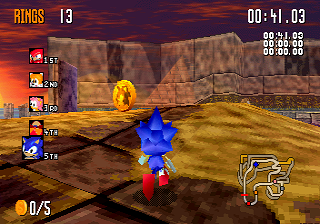
Sonic Token, in the Regal Ruins world
Aside from activating the acceleration pads, rings collected can open doors that lead to certain shortcuts. At a cost of either 20 or 50 rings, players can unlock these extra pathways during the race. The challenge is to balance picking up as many rings as possible while still taking efficient racing lines and being strategic on when to use the acceleration pads or unlock shortcuts. Once a shortcut is opened, any character in the race can use it, so timing is of utmost importance. What’s more, many of the collectables (Sonic tokens, Chaos Emeralds) are often found behind shortcut doors, and of course, for any of your tokens or emeralds to ‘count’ once the race is done, you need to finish high in the standings. That makes Sonic R a high-speed strategy game.
In yet a further break from traditional kart racers, there are no pickups specifically aimed at hindering or damaging your opponents. Aside from Robotnik’s bombs, there are no projectiles in the game. Add that to the already spaghetti-like tracks with multiple paths, and this game begins to look less like a game that would fit any conventional category and more like a high-speed strategic adventure collect-a-thon with a strong racing element and clothed in the trappings of the Sonic universe. Please, don’t think of this as just a racing game, or a kart game, or even a bona fide Sonic platforming game, because it really isn’t any single one of those things, and coming in with those expectations will ultimately lead to frustration with the title. It’s best to approach what is a very interesting genre-blending title with an open mind and no preconceived notions.
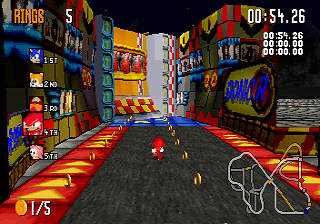
The texture work is exquisite
If the overall style of this Sonic game draws strong opinions, then the soundtrack is where things start to get extremely polarizing. Nowhere in sight are the series’ traditional composers Masato Nakamura (Sonic 1, 2) or Jun Senoue (Sonic 3, Knuckles). Sonic R is scored entirely by the brilliant Richard Jacques, who, at the behest of Yuji Naka, included vocals in all the main in-game music tracks. As a result, we have a game that sounds markedly different from previous Sonic outings, and whilst some fans love the sugary-pop lyrics (voiced by TJ Davis), some detest them with a passion that burns hotter than a blaze on an abandoned space colony*. It’s a high-tempo, high-stimulation sort of experience. The result is comparable to taking a Sonic game and giving it lots and lots of sugar, and watching it suddenly get very hyperactive and becoming best friends with caffeine. Tracks such as Can You Feel the Sunshine, or Living in the City are happy, happy tracks, and will have you vomiting rainbows and burping lollipops. Whether you love them or not so much, they are certainly well done studio tracks and make for a unique experience with this Sonic game, as vocals haven’t been used this heavily in any subsequent Sonic game. It should be mentioned that yes, there is an option to turn off the vocals, and what you’re left with is a milder soundtrack. It’s very good, if not somewhat different from what you’d expect a Sonic game to sound like.
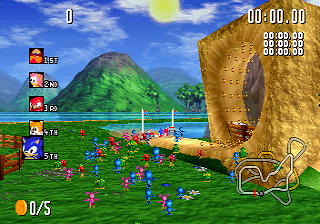
Doing loops in 3D is a lot less fun than in 2D
By examining the controls of the game, we discover yet another level of love-or-hate. Those used to traditional Sonic’s control are in for a much slipperier affair. Even using the supported 3D Analog Pad, Sonic et al. all handle with way more momentum than purists are used to, and this can be a point of frustration. In fact, the characters are all equipped with a hard-bank feature (L or R triggers) and this really makes the game reminiscent of WipE’out”’s control scheme. Yes: this game plays more like WipE’out” than any previous Sonic game. Is this a good thing? You be the judge of that, but the learning curve is steep. Initially, players are bound to be bouncing off walls, careening into the water because they couldn’t negotiate tight turns, or missing lanes and smashing into barriers instead. It gets much better once you climb that learning curve; a big part of that involves de-programming yourself from thinking this is a traditional Sonic game. It just doesn’t control that way.
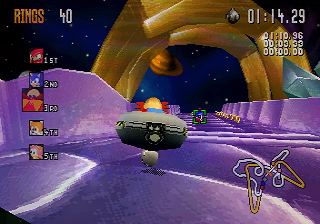
Robotnik targeting Sonic ahead of him
The game features your standard racing modes: single player allows you to race against 4 CPU characters and attempt to collect rings / tokens / emeralds, 2-player is an excellent split-screen affair which can be a race or a balloon seeking challenge or even a game of tag, and of course we have the time trial option. The balloon pop and tag games are an especially welcome addition and can be a lot of fun under the right circumstances.
It must be mentioned, the visuals are utterly amazing – the 3D is solid and colorful, the frame rate is excellent and rock-steady, and there is even (gasp!) a plethora of stunning graphic effects that many thought were impossible to achieve on the humble Saturn! From full-on transparencies to fade-in scenery to great rippling water effects to even the metallic, reflective Sonic head during the loading screens, this is a game that is pushing the Saturn in directions that had rarely been attempted before, and certainly not simultaneously. Sonic R was programmed by the same crew who did the visually stunning Toy Story on the Genesis – in particular, programmer Jon Burton had a knack for squeezing unexpected power from the consoles he worked on, often making the hardware work in ways that no one else had thought of. Even in the impressive split-screen 2 player mode the frame rate doesn’t appear to dip. In a sense, Sonic R is a technical masterpiece. How was all of this achieved whilst maintaining the frame rate? A few clues lie in the relatively simple 3D architecture and the cleverly low-resolution textures, all masked by track design and excellent use of color and pixel-friendly patterns in the texture assets. Sonic R is definitely one of the best 3D exemplars of the various graphical effects the Saturn was capable of when expertly programmed – in that respect, the game can easily go toe to toe (visually) with the contemporary Mario Kart 64. In terms of visual criticisms, there are a few. As awesome as the fade-in backgrounds are, and as well as they blend in with the backdrop art, it is sometimes disorienting when something pops into view in front of what turns out to be the backdrop – this goes a long way to confound the illusion of depth the game is weaving. Also, the camera can be infuriating at times – it often positions itself outside the paper-thin borders of the play field, and the player is left looking at game walls from the wrong side. This is critical because it really destroys the ‘solid’ feel of the world and is a rude reminder that the textures, often bricks or cave walls, are in reality paper-thin.
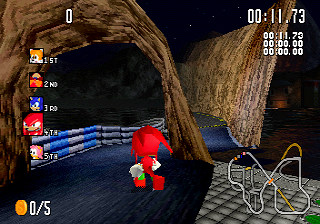
Camera clipping issues on display
Verdict? Overall, the game is surprisingly fun, once you climb that learning curve. However, 3D Sonic on Saturn (compared to, say, 3D Sonic on Dreamcast) is like comparing 2D Sonic on the Master System to 2D Sonic on the Genesis / MegaDrive. The Saturn just isn’t cut out to handle a traditional 3D Sonic game in a way that would do the character proper justice. That said, what we got for Sonic’s final Saturn adventure is a visually spectacular rendition of perhaps the best 3D setting for Sonic that the Saturn hardware could manage. Accordingly, the gameplay is different to match this change in game style. Coupled with the unconventional soundtrack, it’s easy to see why this is such a polarizing title. With all of these changes to the Sonic formula, players either understand and accept the paradigm shift and thus enjoy the game, or they don’t. If you approach the game with an open mindset as opposed to the expectations (and subsequent disappointment) of this being a traditional 3D Sonic game, you’ll do all-right with Sonic R.
Shiro Challenges
- There is an excellent exposé on YouTube detailing how some of the graphical effects were achieved, over on Jon Burton’s (programmer of Sonic R) channel, ‘Game Hut’. The way the fade-in scenery was executed is particularly impressive. The full title of the video is “Sonic R’s “Impossible” Fading – CODING SECRETS”. Watch it!
- Unlock all extra characters and tracks! You really must handle your character well (i.e., learn to play the game properly) to be able to meet all the conditions necessary to achieve this.
- Spend some time in the Time Attack mode. The challenges (balloon pop, tag) are really fresh and well done, and are a fun way to learn the layouts of the spaghetti-like worlds!
- Learn the lyrics to a few of the songs. What… what’s that? You already know them? And they’re stuck in your head? Um… you’re welcome!
Did you know? Back in 2015, SEGA considered releasing a quasi-sequel to Sonic R, titled Sonic ARR, and the game would have had a heavy pirate theme. JK. That is totally untrue.
Bonus: Who Actually Made This Game?
While the game was programmed by Travelers’ Tales, the tracks were designed by the Sonic Team themselves. This gives the game the Sonic Team flavor. The tracks are all contained in relatively cubic play environments, which appears to have been the best way to have the Saturn handle all the data without inter-level loading. It also gives the game its’ signature spaghetti track feel. These are definitely early days in 3D world-building: Sonic’s famous loop makes an appearance right in the Resort Island level, but it is actually much more efficient for the player to simply run around it as opposed to committing to the loop. Still, the track designs are varied and are a very good ‘first attempt’ at building a world for Sonic and pals to race around.
For the Nerds: The five levels in the game are named: Resort Island, Radical City, Regal Ruin, Reactive Factory (?), and Radiant Emerald. Notice a trend? They all start with the letter R. Because, Sonic R.

Early concept art for the Sonic R box
*The fires of the abandoned space colony is a nod to Burning Rangers – the last Saturn game that the Sonic Team would develop.

A Saturn fan since the beginning, Peter plays Saturn almost exclusively. For Peter, Saturn represents a moment in time where 2D games were at their best, 3D was just rising, and fascinating gaming ‘firsts’ were commonplace. There are very few Saturn games that Peter cannot find some enjoyment in!
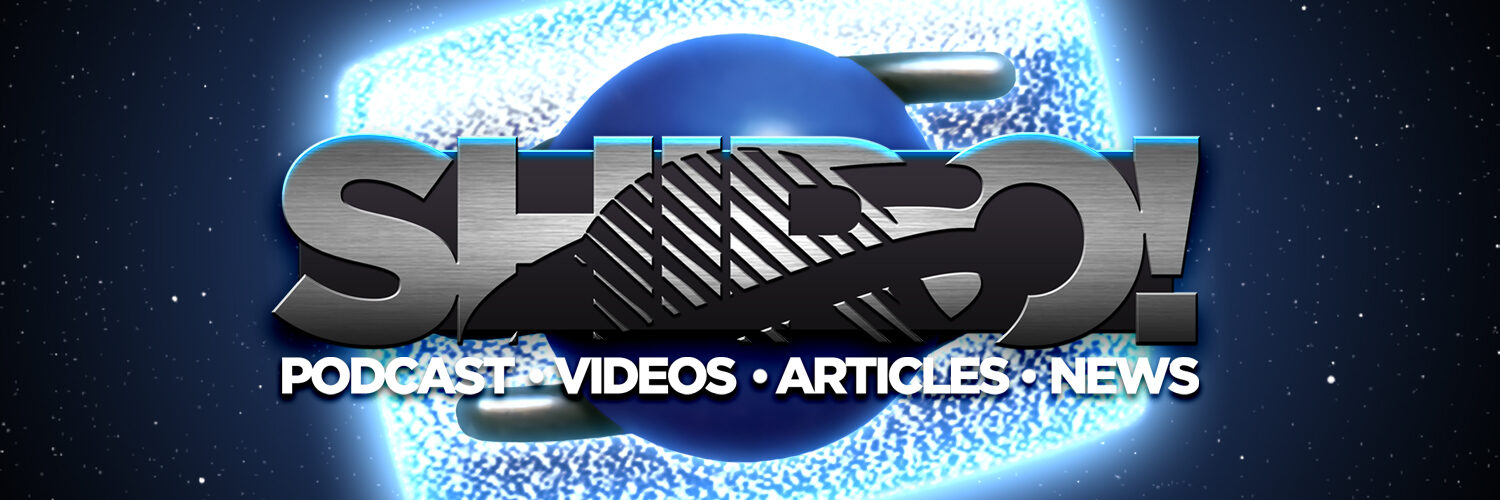

Be the first to comment